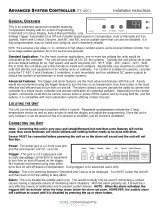
2.1.8 Freeze Mode (25, 26)
If desired, the frequency of the drive can be frozen at its present value. The mode is indicated by data point 25. It is an option available when serial
interface is lost.
2.1.9 Coast (27, 28)
The coast command (28) shuts down the inverter and makes the motor freewheeling, which normally brings it to stand still. The drive cannot be restarted
in any mode before the coast command is removed. It is, therefore, often used as a safety interlock. Data point 27 indicates when the drive is coasted.
2.1.10 Motor Ramp-up and Ramp-down Rate (31, 32)
The time to accelerate or decelerate the drive between 0 Hz and the motor’s nominal frequency can be programmed. The drive is capable of settings
between one to 3600 seconds (one hour). Only Ramp1 is accessible from the FLN network.
2.1.11 Hand/Auto Modes (34)
The
SEL HND.AUTO
shows which mode the drive is in. The drive can be commanded into either
Hand
or
Auto
mode by pressing the respective keys on
the keypad of the drive. Hand mode disables any programmed control strategies and allows the drive keypad to be used to set the drive speed. The only
serial communication command that can override Hand mode is data point 28,
CMD COAST
.
2.1.12 CMD RUN STOP (35)
Set data point 35 to
ON
to run the drive from the FLN with default drive parameter settings. In the
OFF
mode, the drive will run only in Hand mode or
in Auto mode from the drive‘s digital control terminals. par. 8-53
Start Select
, controls the interaction of point 35 and the digital run command.
2.1.13 Bus Functions (36, 37)
The amount of time the drive will wait between communication packets is programmable. If the time is exceeded, the drive will assume serial commu-
nication has stopped and respond with programmable choices. The drive can ignore the loss, freeze its current output, stop, run at a predetermined jog
frequency, run at maximum output frequency or stop and trip while issuing an alarm. Wait time is selected at point 36 and the function after a timeout
at point 37. See descriptions for par. 8-03
Control Timeout Time
and par. 8-04
Control Timeout Function
in the
VLT HVAC Drive Programming Guide
.
2.1.14 Jog Frequency and Command (38, 39)
The Jog Frequency can be set by data point 38. Setting data point 39 to [On] will cause the frequency converter to send the Jog Frequency to the motor.
2.1.15 Relay Out 1, 2 (40, 41, 43, 44)
Two programmable relay outputs (Form C, 240 VAC, 2 Amp) are available. These can be triggered through the serial bus by command points 40 and 41.
This allows the FLN to utilize the drive’s built-in relays as additional network programmable relays. The data points 43 and 44 indicate whether the relay
is triggered or not (On/Off). Parameters 5-40.0 and 5-40.1,
Function Relay 1
and
Function Relay 2
, must be set to [45] Bus controlled, [46] Bus controlled
1, if timeout or [47] Bus controlled 0, if timeout.
2.1.16 PID Control Functions (61-65)
The VLT has a sophisticated built-in proportional, integral, derivative (PID) controller. The PID controller is activated by setting par. 1-00
Configuration
Mode
, to Closed loop through the drive’s keypad.
2 VLT Functional Features VLT
®
HVAC Drive FLN Operating Instructions
8
MG.11.Z2.02 - VLT is a registered Danfoss trademark
2




















